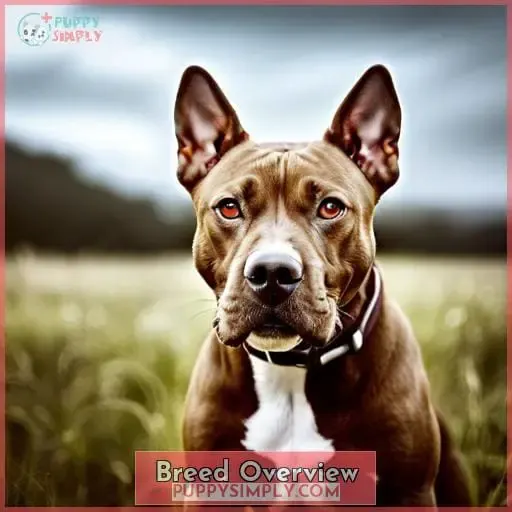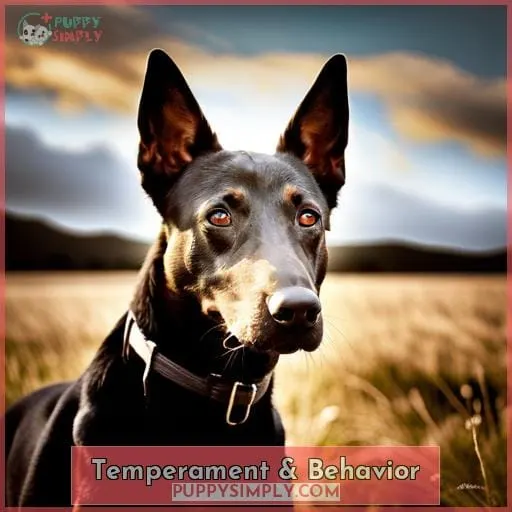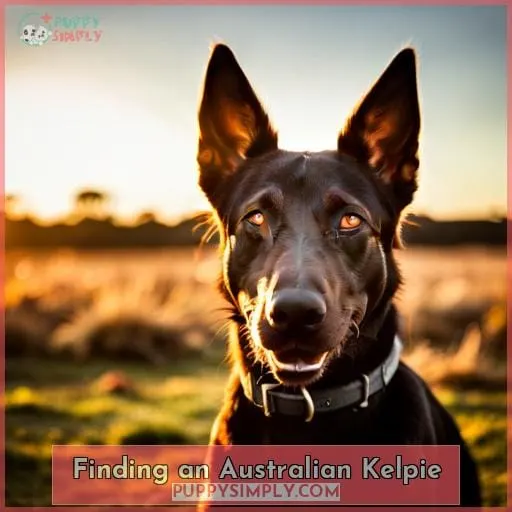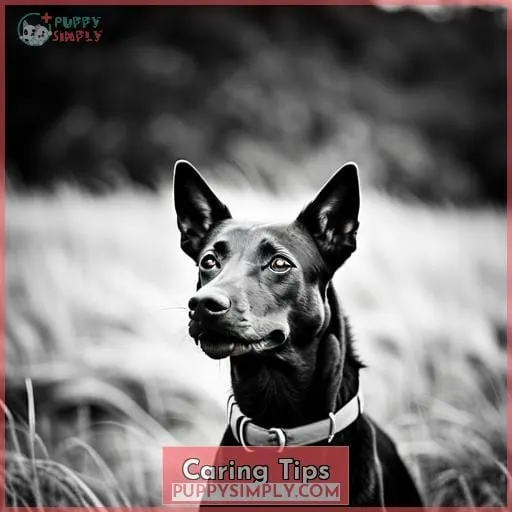This site is supported by our readers. We may earn a commission, at no cost to you, if you purchase through links.
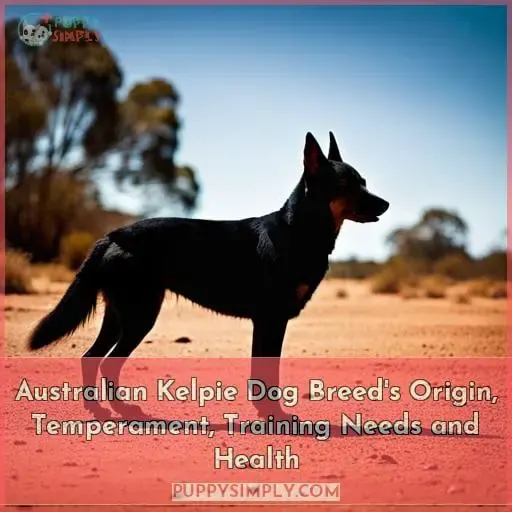 Gazing into a Kelpie’s keen eyes, one glimpses the fiery spirit of Australia’s outback.
Gazing into a Kelpie’s keen eyes, one glimpses the fiery spirit of Australia’s outback.
Like a loyal drover, this agile workmate bonds profoundly with their human flock, intuitively anticipating needs.
Though demanding considerable activity, these animals thrive when their intelligence is engaged through training.
Meet a soulmate who will walk life’s rugged miles by your side.
Table Of Contents
Key Takeaways
- Developed in Australia for herding due to intelligence, trainability, and endurance
- Medium-sized muscular breed with strong herding instincts demanding proper stimulation
- Highly energetic, requiring at least 30-60 minutes of exercise and mental stimulation daily
- Short, easy-care coat with straightforward grooming needs
Breed Overview
Since Australian Kelpies are medium-sized herding dogs that originated in Australia, you’ll want to learn about their history, physical traits, temperament, exercise needs, and health.
As herding dogs developed in the late 1800s for working sheep flocks, Kelpies exhibit exceptional skills with livestock due to their intelligence, trainability, stamina, and agility.
Their energetic, devoted nature makes them wonderful working dogs and active companions.
However, their intense exercise requirements and potential health issues like hip dysplasia demand research into their care needs.
Understanding the Kelpie’s origin, temperament, training demands, and health considerations provides the foundation to appreciate this hardworking breed.
Origin & History
Your Australian Kelpie descended from working collies brought to Australia in the late 1800s. There, they were crossed with local dogs and named after a talented female named Kelpie.
These medium-sized herding dogs originated from Scottish collies and were further developed by Australian sheep farmers seeking an agile, intelligent dog to manage their flocks. Their ancestry gave them a strong herding instinct, trainability, and endurance that made them well-suited to the harsh Australian outback.
In the early 1900s, a dog called Kelpie produced exceptional working pups at a sheep farm, leading this line of canines to be referred to as Kelpie’s pups. Their talents were showcased when Kelpies began participating in and often winning sheepdog trials, including a triumph at the Forbes trial.
This success cemented their reputation across the land as an all-around exceptional sheep herding breed.
While not recognized by major breed organizations, Australian Kelpies remain an integral part of ranch life and continue demonstrating their worth at stock shows today.
Physical Attributes
Its solid, muscular appearance gives the medium-sized Australian Kelpie dog breed your typically devoted, tireless working dog look.
Males stand 46-51 cm at the withers and weigh 15-20 kg, while females are 43-48 cm tall and 11-16 kg.
They’ve a short, flat coat that lies close to the body and is easy to groom. It comes in colors like black, chocolate, red, smoke blue, and fawn.
Their obedient nature and intelligence makes them highly trainable.
With proper care including regular exercise, balanced diet, training, and health checks, the Australian Kelpie makes an excellent working dog or active companion.
However, health issues like hip dysplasia, eye diseases, and spinal cord disorders can affect the breed.
Temperament & Behavior
Australian Kelpies have a strong herding instinct.
Their intelligence and eagerness to please make them highly trainable.
Proper training and activities are key to channeling their energy and preventing problem behaviors.
Herding Instinct
You’re staring down a strong herding drive when you bring home an Australian Kelpie.
Their keen working instincts and boundless energy demand proper outlets like herding trials, canine agility courses, or vigorous daily exercise.
Obedience training and mental stimulation are essential to manage their intense herding challenges and prevent destructive behaviors.
Providing tasks activating their herding talents keeps these intelligent dogs engaged and content.
Training & Intelligence
These intelligent dogs of yours are highly trainable and eager to please their owners.
Engage their canine IQ with mental stimulation like commands, tricks, and games that provide obedience techniques while avoiding repetitive training challenges.
Incorporate daily mental and physical enrichment into their routine for a healthy, happy Australian Kelpie.
Exercise Requirements
How much exercise does an Australian Kelpie need daily for optimal health and happiness?
As extremely energetic working dogs bred for herding livestock across vast territories, you’re looking at a minimum of 30-60 minutes of vigorous activity per day.
Providing adequate outlets for their exercise needs is key to preventing destructive behaviors from boredom.
Interactive games, outdoor adventures, training challenges, and playtime varieties are vital components of a Kelpie’s daily fitness routine.
Activities like fetching, agility courses, or running alongside a bicycle allow them to expend pent-up energy.
Additionally, activities that engage their intelligence like advanced training tricks keep their minds occupied.
Without proper stimulation, these intelligent pups may resort to nuisance barking or destructive chewing.
Establishing set exercise routines curbs these behaviors and supports preventative health through activity.
Grooming Needs
Having covered the considerable exercise requirements of the Australian Kelpie, let’s now turn our attention to their grooming needs.
While their short, straight coat is low maintenance compared to other breeds, you’ll still need to brush them weekly to control shedding.
Regularly check and clean your Kelpie’s eyes, ears, teeth, and paws as part of their grooming routine as well.
Overall, Kelpies have straightforward grooming requirements in line with their no-fuss working heritage, but don’t neglect these areas of care. Maintaining their coat, eyes, ears, teeth, and paws keeps them comfortable and healthy.
Health Issues to Watch For
As an owner, you’ll want to watch for common Kelpie health problems:
- Hip dysplasia, a deformation of the hip joint, can cause significant pain and mobility issues.
- Eye diseases:
- Progressive retinal atrophy (PRA), a degenerative eye disease, can lead to blindness.
- Collie eye anomaly affects the choroid layer of the eye.
- Degenerative myelopathy is a debilitating spinal cord disease.
Your vet should screen for these conditions.
Regular dental care is also key, as gum disease is prevalent.
Staying vigilant about your Kelpie’s health will help them live their longest, healthiest life as your loyal companion.
With some preventative care and close monitoring, you can keep your energetic Kelpie happy and active well into their senior years.
Finding an Australian Kelpie
Now that you’re aware of the health issues to watch for in Australian Kelpies, let’s move on to finding your perfect companion.
When it comes to finding an Australian Kelpie, there are a few options available to you.
One option is choosing a reputable breeder who specializes in this breed. A good breeder will ensure that their dogs have been properly socialized and screened for any potential health issues.
Another option is adopting from a rescue organization or shelter, where you can provide a loving home for a Kelpie in need.
The adoption process typically involves filling out an application and going through an interview or home visitation process.
Additionally, consider enrolling your Australian Kelpie into training classes as they have specific temperament and training needs due to their intelligence and high energy levels.
Socialization tips include exposing them early on to various environments, people, animals, and experiences so they can develop into well-rounded adults.
Bringing One Home
You’ll want to have everything ready before bringing your new Australian Kelpie home.
Choose your breeder responsibly to ensure a happy, healthy pup.
Puppy-proof your home by removing hazards and securing fragile items.
Stock up on a crate, bed, bowls, collar, leash, toys, and nutritious puppy food.
Read up on training techniques like positive reinforcement.
Socialization is key – introduce your Kelpie to new sights, sounds, people, and animals.
Allow time for naps and play.
Set up a feeding and walking schedule.
Provide lots of chew toys to curb destructive chewing.
Be patient during the adjustment period.
With preparation and commitment, you’ll have a devoted companion for life.
Investing in early training will ensure a well-mannered dog.
Caring Tips
- When it comes to diet, feed them a balanced meal with meat, veggies, and appropriate portions.
- Preventative care through annual vet check-ups, flea and tick prevention, and regular dental care will help your Kelpie stay healthy.
Diet
For Kelpies’ diet, you’ll want to feed them a balanced meal with meat and plant-based ingredients to meet their nutritional needs as medium-sized, energetic dogs.
Provide high-quality dry dog food formulated for active breeds.
Supplement kibble with cooked chicken, beef, fish, or eggs.
Monitor portions to prevent weight gain that stresses joints.
Preventative Care
Regular check-ups, flea and tick prevention, and dental care will be essential for preventative care of your Australian Kelpie.
Schedule annual veterinary exams to catch issues early.
Use monthly preventatives to eliminate parasites externally and internally.
Brush teeth daily, get professional cleanings to promote your pup’s dental health.
These steps will enable you to enjoy a long, healthy life with your devoted Kelpie companion.
Frequently Asked Questions (FAQs)
What colors do Australian Kelpies come in?
Australian Kelpies come in a variety of coat colors, including classic black, chocolate brown, blue, red, fawn, tan, and combinations of these.
The breed originally came in tan and black, but breeders have since introduced more color variety while retaining the Kelpie’s signature agility, endurance, and working ability.
How big do Australian Kelpies get?
Australian Kelpies typically stand 17 to 20 inches at the shoulder and weigh 30 to 45 pounds when fully grown.
Though a medium-sized breed, their athleticism and energy make them seem larger than life.
Still, their compact size helps them excel at maneuvering livestock.
Are Australian Kelpies good with cats?
Australian Kelpies usually do well with cats if properly socialized.
However, their strong herding instinct means they may try to herd or chase cats.
With training and early exposure, Kelpies and cats can coexist peacefully.
But supervision is still recommended.
How long do Australian Kelpies usually live?
You can expect your loyal Australian Kelpie to be by your side for 10-13 years.
With proper care, exercise, and veterinary attention, some Kelpies live even longer.
Give your energetic companion the best life possible, and they’ll reward you with over a decade of devotion.
Are Australian Kelpies easy to potty train?
Yes, Australian Kelpies are typically easy to potty train.
Their intelligence and eagerness to please make housetraining them a breeze.
Be consistent with taking them out frequently and praising successes.
Most Kelpies will pick up potty training quickly.
Conclusion
You know this dog will suit your rugged Aussie lifestyle.
Their intelligence means a Kelpie will rise to any training challenge.
Providing an outlet for their limitless energy will create an unbreakable bond.
So bring home an Australian Kelpie if you desire a loyal friend who relishes working as hard as you do.
With the right care, this spirited Australian Kelpie companion will be by your side traversing life’s vast outback.

